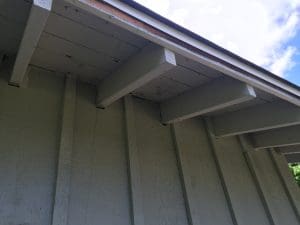Some roofs have exposed eves which means that they don’t have soffit. Without a vented soffit, cool intake ventilation air cannot get into an attic.
Ventilation is a 2-part system, intake and exhaust.

Most homeowners and some roofers are only familiar with exhaust ventilation. That is the vents that you can see when looking at your roof. Yes, those exhaust vents can allow hot air to get out, but only if there is a place where air can get it. Without intake ventilation, your roof and attic space would be like one giant vacuum where air cannot travel and where heat is trapped.
In houses where the eves are exposed to the outside, there is no traditional way to provide intake air. In those houses, the areas where air would normally flow is blocked off.
But don’t worry, there are workarounds that can help most of these homeowners.
In-deck intake ventilation allows air to get into the attic or crawlspace cavity and exhaust through the top.
Some roofers understand this and put an intake vent lower on the roof. But rather than putting a traditional pod vent, sometimes referred to as a turtle or mushroom vent, you can install a low-profile vent.
Low-profile vents such as the Lomanco Deck-Air vent should be installed above the insulation line in the attic, but still as low as possible on the roof to allow proper intake ventilation. Convection will draw the air up to the top so it can be vented out. Most roofers today are using either pod vents or a ridge vent for exhaust ventilation.
The quantity of air that vents give you is called “net-free air”. As a rule of thumb, you cannot have too many intake vents but you can have too much venting for exhaust vents. By properly calculating exhaust vents, and allowing enough intake ventilation to feed that exhaust ventilation, you can achieve optimal ventilation.

